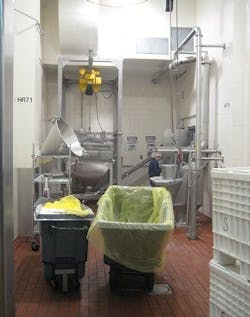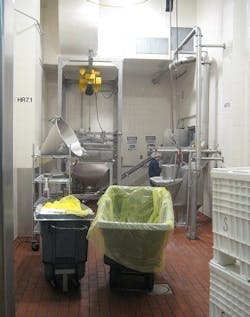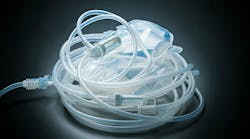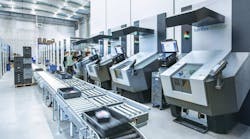A well-designed, reliable raw material storage and conveyance environment can make or break a pharmaceutical manufacturing environment. Raw material storage and conveyance is fundamental to quality assurance and profitability. Increasingly, this environment also has become integral to the rigorous regulatory requirements for tracking and tracing products throughout the supply chain. To meet quality and standardization objectives, a design solution must be based on an overview of the entire process from delivery of raw materials to the manufacturing site to delivery of product ingredients to the manufacturing line. The correct design basis is predicated, particularly, on an understanding of raw material characteristics and facility conditions.
Supersack handling system for bulk dry ingredients.
DUE DILIGENCE: STARTING A DIALOGUE
The correct design approach is practicing due diligence. Owners and their internal process engineers contribute to a solid basis of design with information about their overall objectives, constraints and future potential changes, as well as knowledge of specific issues associated with raw materials and the facility itself.
Manufacturers and vendors often have detailed information about the properties of the raw materials they supply in material safety data sheets. However, when in doubt about the properties of a raw material, the prudent engineering team always sends out samples for independent testing and verification.
Operations, quality assurance, maintenance and procurement personnel often have valuable insights about their issues, challenges and past experience with raw materials storage and conveyance systems. Experienced engineering teams communicate with them when developing and reviewing the basis of design. In fact, when an engineering team initiates dialogue with all stakeholders, they often gain unique and valuable insights that cannot be obtained in any other way.
For example, talking with operations and maintenance personnel often yields information about subtle operational parameters that can positively influence design, such as how the product is used, handling methods or storage times in intermediate bins or conveyors. There may be variations in environmental conditions that affect the material, or there can be material properties that affect handling, which may not be included with the supplier’s information.
Pragmatic engineering teams ask questions that reveal issues that might not be readily apparent, even to a design engineer. For example, O&M personnel might have noticed bridging or plugging problems that have created unanticipated maintenance or cleaning issues. As a result of this insight, the engineering team would select equipment and design the system to mitigate these issues.
Product Dryer with CIP
They might have noticed that seals or bearings on rotary airlocks wear out because of the physical environment, causing leakage. As a result of this insight, the engineering team might include an air purge or airlocks in the bearing housing. Or they might report product clogging of the conveying line due to heat build-up in the material storage and conveyance process. In this situation, the engineering team employs air cooling in the conveyance system.GET TO THE HEART
To get to the heart of these issues, it is essential to uncover memories about issues from months or years in the past. To facilitate the concentration required for this, engineers should interview operations personnel away from their day-to-day activities in a place without distractions, such as a conference room, for an hour or two at a time.
Recounting various design scenarios, the team starts by asking questions about the fundamentals: Quantities of raw material used today, future projections, current supply sources, current conveyance rates and their adequacy, problems in receiving materials, and so forth. Once personnel have answered these fundamental types of questions, the engineering team can go into some of the more obscure issues and problems.
Often, the engineering team can draw out the most valuable insights by asking the conceptual question, “What would you change about this system to make it better?” This question gets at some of the operational problems that are the result of overlooking a key parameter in the original design.
The dialogue should not end with the initial interview process. The engineering team provides and reviews a description of operations so that stakeholders understand how the system is going to work when it is installed and have an opportunity to offer feedback. Their feedback, especially about specific points in the operator-system interface, contributes to refinements in the final design.
This communication process is a wise investment that ultimately saves the owner time, effort and expense because it enables the engineering team to design a system that meets functional objectives with minimal operational and maintenance downtime.
STORAGE: GOOD DESIGN IS IN THE DETAILS
Understanding raw material characteristics is fundamental to good design in every component of the environment, yet even some experts fail to consider important details. Storage is a crucial aspect of the design.
Sizing and shelf life. The optimal storage container must be large enough to achieve economies of scale, allow easy emptying and refilling, and have surfaces compatible with the characteristics of the raw material. Process design engineers typically account for the basic physical properties of raw materials and the effect on container size, and major equipment, such as blower horsepower, lines and so forth. However, even some experts overlook the impact of a raw material’s shelf life on the design of the receiving and storage components. Why design and specify a silo that can handle two truckloads of raw materials if the manufacturing operations will take three months to use it all and the shelf life is only 60 days? Perhaps a system that is designed for sacks and super-totes would be a better alternative.
Similarly, particle size may be important in the product formulation or final product. In fact, it can be critical where filling or tableting operations require certain particle size ranges for optimal performance in batches. Failing to account for shelf life has an adverse impact on GMP, quality assurance and profitability. This can be problematic if storage time exceeds the supplier’s warranty period for product viability. Purchasing large quantities of a material may provide a cost benefit. However, if the batch sizes are small or if the material is a minor ingredient, the material may exceed its shelf life prior to being used.
Material-surface interface. Equally important is the interface between the container’s surface and the material inside. Given a corrosive material such as urea, for example, stainless steel would unquestionably make a more durable and cleanable containment surface than fiberglass. Furthermore, using stainless steel may be the most cost-effective choice in the long run. It is far less likely to require replacement if the process will involve a corrosive raw material in the future.
Climate control. The container must be designed around the susceptibility of the raw material to humidity, airborne microbes and extreme temperatures. To prevent a hygroscopic material such as a sugar from absorbing water and clumping or degrading, humidity must be kept low. Temperature control is important for heat-sensitive materials such as glucose, and for materials that are vulnerable to microbes. For example, for storage of soy meal, engineers can use HEPA filtration or UV treatment of the air in the top of the container.
Bin activation and fluidization. Bin activation systems must be configured to match the material’s angle of repose, its hygroscopic parameters, and particle size, all of which are related to flow. While some raw materials flow easily out of a cone bottom, others tend to bridge and obstruct free flow. With a hygroscopic material, for example, the storage container can be designed with an envelope dehumidification system and air pads on the container bottom to facilitate flow. Some materials require bin activation using a vibratory or a screw conveyor. However, if the system is hard to clean, the raw material may build up, especially at transition points. In that case, fluidizing may be a better solution, and a fluidizing disk that is compact, self-cleaning and economical is the best choice.
SSOE Group designed a raw material storage and conveyance system for a sugar that was heat sensitive, hygroscopic, and created a dust that was explosive under certain conditions. The design addressed these characteristics using dehumidification, conveyance air cooling and explosion suppression. In the wake of its implementation, the following challenges and design insights were revealed:
• Greatest challenge regarding sugar: To account for all those parameters and put in the required cooling, explosion suppression, etc., and still make a system that is cleanable and safe for the product.
• Solution process: A combination of selecting the right components and designing and specifying the right construction methods.
• How: due diligence, especially obtaining the detailed info from the vendors offering the components.
• Selection criteria: If there is cooling, is it a heat exchanger; details of fin spacing, depth of coil, and access for cleaning; construction methods and materials of construction. On heat exchangers, for example, there may be components that are not readily accessible for cleaning. Operators might spend a lot of time taking them apart in order to clean them. They are fine in some applications, but not in a GMP application.
• Potentially overlooked detail: There are many components that work in other industries, other applications, but might not be the best choices for a pharmaceutical client.
• Critical success factors: The materials of construction and access for cleaning were the two main factors.
Construction materials and accessibility for cleaning. The materials of construction and access are major design factors in assuring a clean storage and handling system. A clean system is critically important in pharmaceutical manufacturing to assure product quality and safety. A clean system also protects the flow of material against clumping or dredging, reducing maintenance downtime. A clean system reduces the need for extra processing steps, such as sterilization, which lowers operating costs and ensures quality. For example, many manufacturers will heat a slurry to sterilize it before adding it to their fermenter as a hedge against contamination in unreliable storage conditions.
With cleaning issues in mind, the prudent engineering team typically specifies stainless-steel materials with an 80-grit or better surface finish without crevices or corners where the product could collect. An effective design solution streamlines the container and conveyance system to eliminate or limit transition points and designs remaining transition points with maximum bending radii to allow a free flow of material. The construction methods should also allow operators to take apart and reassemble components as quickly as possible — with minimal tools — to reduce operational downtime. The subtleties of the operation cannot be overlooked in the design, such as the amount of time the material is stored in intermediate bins or conveyors.
FACILITY CONDITIONS: EVERY PLANT IS UNIQUE
Specific facility conditions affect the design of a raw material and handling system significantly. A facility assessment and dialogue with stakeholders are essential to develop this understanding. Key parameters include the following:
Level of automation. One of the critical success factors in the design is matching the plant’s level of automation. It may be desirable to totally automate a process to reduce operating expenses; however, it is capital intensive. Also, the plant maintenance personnel would have to be trained to troubleshoot and repair the system when required.
Material availability. Another factor is the availability of material, including lead time and quantity. Some materials may be available in only small containers, so bulk material handling systems are not an option. Systems need to be designed to handle tote, bulk bags, drums of small bags that are ergonomic, sanitary and cleanable.
A well-designed, reliable raw material storage and conveyance environment is a critical success factor for pharmaceutical manufacturing operations’ regulatory compliance, quality assurance and profitability in this highly competitive age. A well-designed, reliable system saves time, effort and expense because it meets performance criteria and functional objectives over its expected lifecycle at the lowest cost.
ABOUT THE AUTHOR
Mark Hoffman, PE, is an engineering manager at SSOE Group. Mark has over 30 years of experience in project and engineering management in the pharmaceutical processing, food processing, nutraceutical processing, bio-processing, renewable energy, ammonia refrigeration and food ingredient industries. He can be reached at [email protected].








